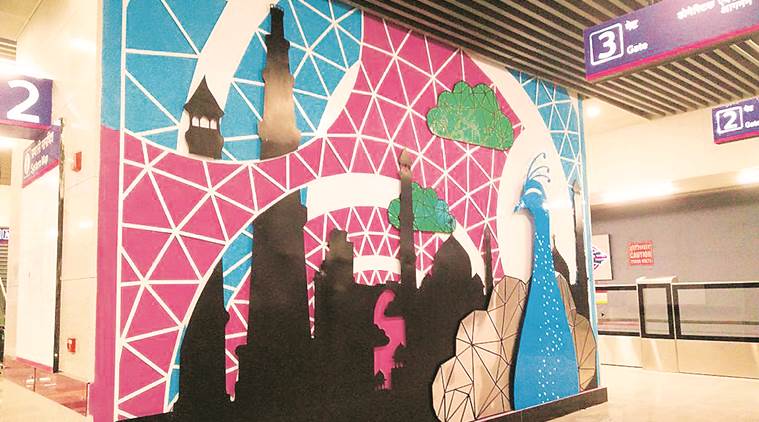Delhi follows trend as artwork adorns city’s new metro stations
The murals are a part of Delhi Hues, a set of three works created by Delhi-based artists Shubhra Chaturvedi and Vibhor Taneja.

The mural at Delhi’s Terminal 1D.
Anyone landing at the Capital’s Terminal 1D and taking the recently opened Magenta line (metro) to either end of the Capital — Noida in the East or Janakpuri in the West — is bound to notice huge murals on both sides of the platform wall. The murals are part of Delhi Hues, a set of three works created by Delhi-based artists Shubhra Chaturvedi and Vibhor Taneja.
Delhi Hues lavishly uses Delhi’s monuments and landmarks — Qutab Minar, Lotus Temple, Red Fort and India Gate. In each of the works, India’s national bird, the peacock, is central. “Peacock is the protagonist of Delhi Hues. It points to the Peacock Throne at Red Fort, which symbolises the power games that go on in the city. Also, peacocks can be spotted at several places in the Capital,” says 45-year-old Chaturvedi, who adds that the airport is significant in terms of the mural as that’s the first place a traveller new to the city arrives at. “The airport mural offers a peek into the city, and also pays a tribute to the city,” she says.
A spokesperson for the Delhi Metro Rail Corporation (DMRC) says, “There are 70 artwork on the entire Magenta Line stretch, of which seven appear at the T1 station.” She adds, “DMRC gives major importance to public art for sensitising people to appreciate it.” Ahead of the Magenta Line’s construction, 14 artists were selected through open advertisement in newspapers and empanelled by a committee.
Chaturvedi’s work can also be seen at Jantar Mantar, Central Secretariat and Jamia Millia Islamia metro stations. Her work at the Jamia station is called Khwabon Ka Kaarvan and is a tribute to the dreams and aspirations of young minds who leave their comfort zone to explore a new world.
Chaturvedi says that the artists weren’t given any theme by the DMRC. However, they were taken to the site to help them conceptualise their works. “The works were selected on the basis of the suitability and appropriateness of the theme in consonance with the surroundings,” adds the DMRC official.
Through murals and art exhibitions, the Capital’s favourite mode of transport is offering a “peek into its culture and heritage to 2.5 million people who take the metro on any given day”. “We have also invited organisations such as Delhi Tourism, Sahitya Akademi and India Habitat Centre to develop the Metro premises as a hub for promotion of art, culture, literature and tourism,” says DMRC Director Anuj Dayal says.
Through these works of art, the DMRC is following a worldwide trend of turning transit points into art hubs. While Naples in Italy displays works by acclaimed artists such as Anish Kapoor and Karim Rashid, Stockholm’s Tunnelbana is often called the longest art exhibition in the world. In Delhi, the Yellow Line and now the Magenta Line have got major emphasis in terms of art initiatives.
In 2014, when Mumbai Airport’s Terminal 2 was built, with its three kilometre-long art wall displaying over 7,000 artefacts and works by as many as 1,500 artists, it was said to give a stiff competition to world-class museums. Even Delhi’s Terminal 3 Airport has artwork and installations at every nook and corner. But Chaturvedi says that art at metro stations serves a different purpose – “it is supposed to take art to the masses,” she says.
“Those who commission artwork at airports are private companies but art at metro stations is commissioned by a government agency, so the aesthetic would be different. The art at metro station also has to be simpler. By exposing metro travellers to art, the perception that art is for the elite and not everyone can understand it, is being challenged. It is to tell people that you don’t have to understand art – just stand, stare, appreciate it and move on,” adds Chaturvedi.
For all the latest Lifestyle News, download Indian Express App






















 The work titled Khwabon Ka Kaarvaan at the Jamia Millia Islamia station.
The work titled Khwabon Ka Kaarvaan at the Jamia Millia Islamia station.
No hay comentarios:
Publicar un comentario